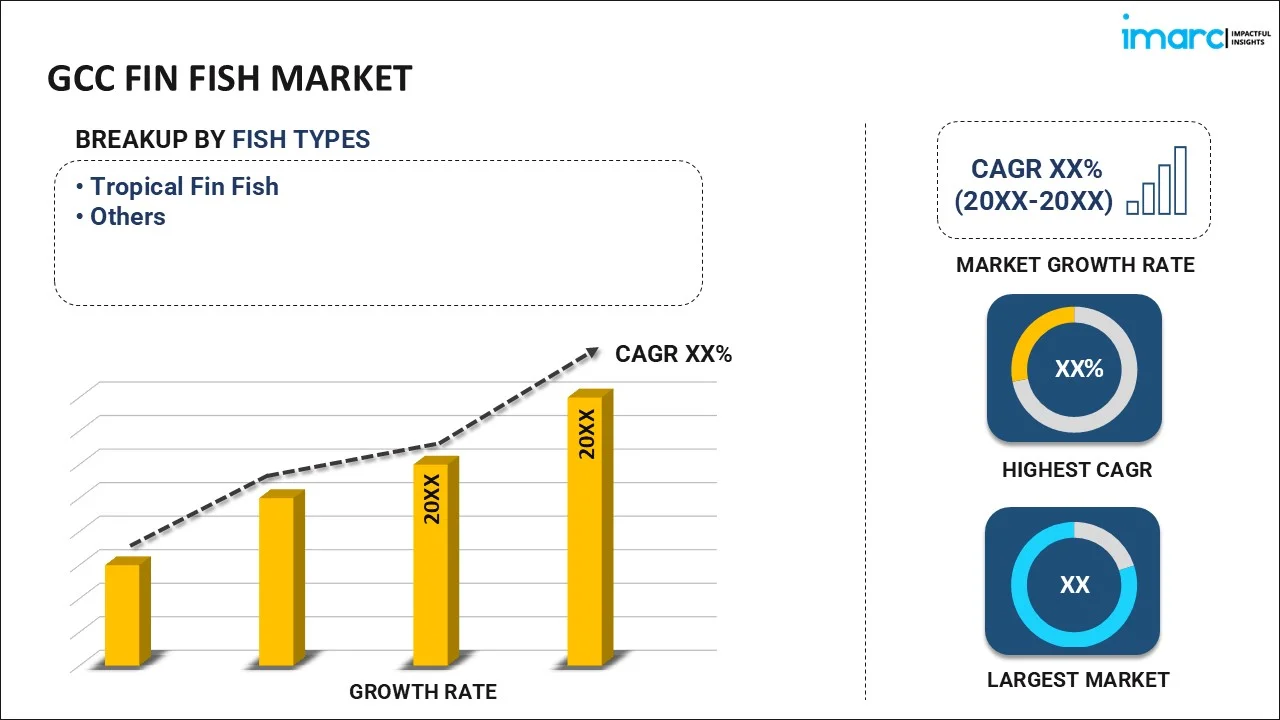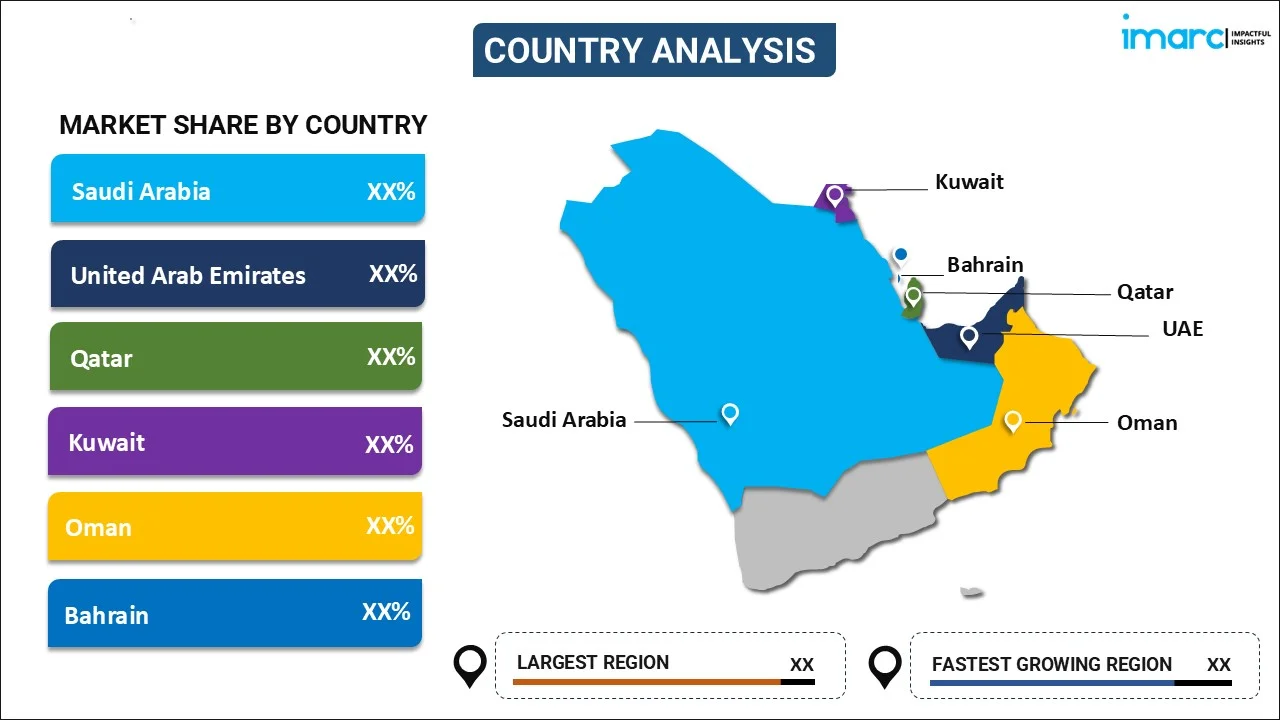
GCC Fin Fish Market Report by Fish Type (Tropical Fin Fish, and Others), Environment (Freshwater, Marine Water, Brackish Water), Distribution Channel (Supermarkets and Hypermarkets, Convenience Stores, Specialty Stores, Online Stores, and Others), and Region 2025-2033
Market Overview:
The GCC fin fish market size reached USD 3.9 Billion in 2024. Looking forward, IMARC Group expects the market to reach USD 5.8 Billion by 2033, exhibiting a growth rate (CAGR) of 4.4% during 2025-2033. The growing consumption of protein-rich diets among the masses to prevent the occurrence of various lifestyle-induced health complications, rising advancements in aquaculture activities to enhance domestic seafood production, and increasing emphasis on sustainable seafood cultivation represent some of the key factors driving the market.
|
Report Attribute
|
Key Statistics
|
|---|---|
|
Base Year
|
2024 |
|
Forecast Years
|
2025-2033
|
|
Historical Years
|
2019-2024
|
| Market Size in 2024 | USD 3.9 Billion |
| Market Forecast in 2033 | USD 5.8 Billion |
| Market Growth Rate (2025-2033) | 4.4% |
Fin fish, also known as teleost fish, are a diverse group of aquatic vertebrates characterized by their streamlined bodies, gills for breathing, and fins for movement. It comprises whitefish, salmonids, tunas, and mackerels, which are fast swimming. It is defined by its ray-finned fins, which are composed of bony rays and provide stability, maneuverability, and propulsion in the water. It consists of an internal bony skeleton and typically has scales covering their bodies. It inhabits diverse environments, including freshwater, marine, and even brackish water. It varies greatly in size, including small species, such as guppies, and large predators, such as sharks and tunas. It can be herbivorous, carnivorous, or omnivorous, occupying various niches in aquatic ecosystems. It is consumed by individuals due to its nutritional content, including lean protein, vitamins, minerals, and essential fatty acids, such as omega 3. It contributes to local economies by providing employment opportunities and fueling international trade. Furthermore, as fin fish is essential for maintaining the balance of aquatic ecosystems, its demand is increasing in the GCC region.
GCC Fin Fish Market Trends:
At present, the increasing demand for fin fish, including anchovies and sardines, as they are used for their distinctive flavor and are often canned or used in sauces is influencing the market positively in the GCC region. Moreover, the rising consumption of protein-rich diets among the masses to prevent the occurrence of various lifestyle-induced health complications, such as obesity, thyroiditis, and diabetes, is strengthening the market growth in the GCC region. Apart from this, the growing utilization of fin fish in various fine dining restaurants and hotels to prepare numerous exotic recipes is offering a positive market outlook. Additionally, the rising awareness about the nutritional benefits associated with fin fish consumption is offering lucrative growth opportunities to industry investors in the region. In line with this, increasing advancements in aquaculture activities to enhance domestic seafood production and reduce the dependency on imports are impelling market growth. Besides this, the rising emphasis on sustainable seafood cultivation, along with increasing concerns about overfishing and marine ecosystem degradation, is propelling the growth of the market in the GCC region. In addition, the wide availability of frozen fin fish via various e-commerce platforms at reasonable prices is bolstering the growth of the market. Furthermore, the increasing adoption of automated feeding systems, water quality monitoring, and disease management solutions for enhancing the production of fin fish and mitigating operational risks is contributing to the growth of the market in the GCC region.
GCC Fin Fish Market Segmentation:
IMARC Group provides an analysis of the key trends in each segment of the GCC fin fish market report, along with forecasts at the regional and country levels for 2025-2033. Our report has categorized the market based on fish type, environment, and distribution channel.
Fish Type Insights:

- Tropical Fin Fish
- Pompano
- Snappers
- Groupers
- Salmon
- Milkfish
- Tuna
- Tilapia
- Catfish
- Seabass
- Others
- Others
The report has provided a detailed breakup and analysis of the market based on the fish type. This includes tropical fin fish (pompano, snappers, groupers, salmon, milkfish, tuna, tilapia, catfish, seabass, and others) and others.
Environment Insights:
- Freshwater
- Marine Water
- Brackish Water
A detailed breakup and analysis of the market based on the environment has also been provided in the report. This includes freshwater, marine water, and brackish water.
Distribution Channel Insights:
- Supermarkets and Hypermarkets
- Convenience Stores
- Specialty Stores
- Online Stores
- Others
A detailed breakup and analysis of the market based on the distribution channel has also been provided in the report. This includes supermarkets and hypermarkets, convenience stores, specialty stores, online stores, and others.
Country Insights:

- Saudi Arabia
- UAE
- Qatar
- Bahrain
- Kuwait
- Oman
The report has also provided a comprehensive analysis of all the major regional markets, which include Saudi Arabia, UAE, Qatar, Bahrain, Kuwait, and Oman.
Competitive Landscape:
The report has also provided a comprehensive analysis of the competitive landscape in the market. Competitive analysis such as market structure, key player positioning, top winning strategies, competitive dashboard, and company evaluation quadrant has been covered in the report. Also, detailed profiles of all major companies have been provided.
GCC Fin Fish Market Report Coverage:
| Report Features | Details |
|---|---|
| Base Year of the Analysis | 2024 |
| Historical Period | 2019-2024 |
| Forecast Period | 2025-2033 |
| Units | Billion USD |
| Scope of the Report | Exploration of Historical and Forecast Trends, Industry Catalysts and Challenges, Segment-Wise Historical and Predictive Market Assessment:
|
| Fish Types Covered | • Tropical Fin Fish: Pompano, Snappers, Groupers, Salmon, Milkfish, Tuna, Tilapia, Catfish, Seabass, Others • Others |
| Environments Covered | Freshwater, Marine Water, Brackish Water |
| Distribution Channels Covered | Supermarkets and Hypermarkets, Convenience Stores, Specialty Stores, Online Stores, Others |
| Countries Covered | Saudi Arabia, UAE, Qatar, Bahrain, Kuwait, Oman |
| Customization Scope | 10% Free Customization |
| Post-Sale Analyst Support | 10-12 Weeks |
| Delivery Format | PDF and Excel through Email (We can also provide the editable version of the report in PPT/Word format on special request) |
Key Questions Answered in This Report:
- How has the GCC fin fish market performed so far and how will it perform in the coming years?
- What has been the impact of COVID-19 on the GCC fin fish market?
- What is the breakup of the GCC fin fish market on the basis of fish type?
- What is the breakup of the GCC fin fish market on the basis of environment?
- What is the breakup of the GCC fin fish market on the basis of distribution channel?
- What are the various stages in the value chain of the GCC fin fish market?
- What are the key driving factors and challenges in the GCC fin fish market?
- What is the structure of the GCC fin fish market and who are the key players?
- What is the degree of competition in the GCC fin fish market?
Key Benefits for Stakeholders:
- IMARC’s report offers a comprehensive quantitative analysis of various market segments, historical and current market trends, market forecasts, and dynamics of the GCC fin fish market from 2019-2033.
- The research study provides the latest information on the market drivers, challenges, and opportunities in the GCC fin fish market.
- Porter's five forces analysis assist stakeholders in assessing the impact of new entrants, competitive rivalry, supplier power, buyer power, and the threat of substitution. It helps stakeholders to analyze the level of competition within the GCC fin fish industry and its attractiveness.
- Competitive landscape allows stakeholders to understand their competitive environment and provides an insight into the current positions of key players in the market.
Need more help?
- Speak to our experienced analysts for insights on the current market scenarios.
- Include additional segments and countries to customize the report as per your requirement.
- Gain an unparalleled competitive advantage in your domain by understanding how to utilize the report and positively impacting your operations and revenue.
- For further assistance, please connect with our analysts.
 Inquire Before Buying
Inquire Before Buying
 Speak to an Analyst
Speak to an Analyst
 Request Brochure
Request Brochure
 Request Customization
Request Customization




.webp)




.webp)












